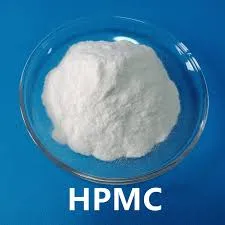
Nov . 04, 2024 18:01 Back to list
HPMC Dispersion Techniques for Enhanced Performance in Material Applications
HPMC Dispersion A Comprehensive Overview
Hydroxypropyl methylcellulose (HPMC) dispersion refers to the process of utilizing HPMC, a cellulose derivative, in various applications across industries such as pharmaceuticals, food, construction, and personal care. HPMC is a white, odorless powder that dissolves in cold water to form a clear solution or gel, making it an essential ingredient for many applications due to its binding, thickening, and film-forming properties.
1. Chemical Properties of HPMC
HPMC is a non-ionic, water-soluble polymer derived from cellulose, a natural polymer found in the walls of plants. The molecular structure of HPMC consists of hydroxypropyl and methoxy groups, which modify its solubility and viscosity properties. The different degrees of substitution of these groups lead to a wide range of HPMC types, each tailored for specific applications.
HPMC exhibits excellent thermal stability and resistance to extreme pH levels, making it a suitable choice for various environments. Additionally, its biocompatibility makes it ideal for pharmaceutical applications, where it can be used as a binder in drug formulations or as a coating agent for controlled-release systems.
2. Industrial Applications of HPMC Dispersion
a. Pharmaceutical Industry
In the pharmaceutical sector, HPMC dispersion is commonly employed in tablet formulations as a binder and disintegrant. The polymer’s ability to swell and retain moisture enhances the dissolution rate of active ingredients, leading to improved bioavailability. Furthermore, HPMC is used in the production of hydrophilic matrices that facilitate controlled drug release, ensuring a steady supply of the medication into the bloodstream.
b. Food Industry
In the food industry, HPMC serves multiple purposes, including as a thickening agent, emulsifier, and stabilizer. Its gelling properties help maintain the texture of various food products, including sauces, dressings, and dairy items. Additionally, HPMC can be utilized in gluten-free products to improve texture and moisture retention, making it a valuable ingredient for consumers seeking healthier alternatives.
c
. Construction Industryhpmc dispersion

HPMC dispersion is also prevalent in the construction sector, particularly in the formulation of cement and gypsum-based products. It enhances the workability, adhesion, and water retention properties of mortars and plasters, leading to improved performance during application and curing. The use of HPMC helps prevent cracking and shrinkage, resulting in long-lasting construction materials.
d. Personal Care Products
In personal care formulations, such as lotions, creams, and gels, HPMC acts as a thickening and stabilizing agent. Its ability to form a protective film aids in moisture retention and enhances the overall texture of the products. Moreover, its compatibility with a wide range of surfactants and oils makes HPMC an effective ingredient in hair and skin care formulations.
3. Advantages of Using HPMC Dispersion
The utilization of HPMC dispersion offers numerous advantages across various industries. Its versatility in modifying viscosity, improving stability, and enhancing product performance makes it a sought-after ingredient. Additionally, HPMC is non-toxic, biodegradable, and environmentally friendly, aligning with the growing demand for sustainable products.
Moreover, due to its unique properties, HPMC can enhance the sensory experience of consumers, particularly in food and personal care applications. The ability to modify the texture and appearance of products can significantly impact consumer preference and brand loyalty.
4. Future Trends in HPMC Dispersion
As industries continue to evolve, the demand for innovative and sustainable solutions will drive the development of new HPMC formulations. Researchers are exploring ways to enhance the functionality of HPMC through modifications and copolymerization with other materials, which could lead to improved performance in applications such as bio-based adhesives and films.
Additionally, the ongoing trend of clean-label products in the food industry suggests a growing reliance on natural and safe ingredients such as HPMC, propelling its market further. The pharmaceutical industry will also continue to benefit from the development of HPMC-based controlled-release systems, addressing the increasing need for precise drug delivery mechanisms.
Conclusion
In summary, HPMC dispersion is a critical component across various industries, providing essential functionalities from binding to thickening and film-forming. Its chemical properties, coupled with its sustainability, make it a favored ingredient in pharmaceutical, food, construction, and personal care applications. As industries continue to innovate and evolve, the role of HPMC is likely to expand, further highlighting its significance in modern formulations.
-
Versatile Hpmc Uses in Different Industries
NewsJun.19,2025
-
Redispersible Powder's Role in Enhancing Durability of Construction Products
NewsJun.19,2025
-
Hydroxyethyl Cellulose Applications Driving Green Industrial Processes
NewsJun.19,2025
-
Exploring Different Redispersible Polymer Powder
NewsJun.19,2025
-
Choosing the Right Mortar Bonding Agent
NewsJun.19,2025
-
Applications and Significance of China Hpmc in Modern Industries
NewsJun.19,2025







